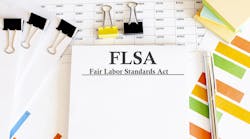With all of the other federal, state and local regulations relating to the COVID-19 pandemic imposed on employers over the last two years, it’s important not to forget some of the older regulations that apply as well. This is particularly the case in regard to employee leave and wage laws that are enforced by the U.S. Department of Labor (DOL).
DOL has issued Fact Sheet #84 addressing the compensability of time spent undergoing COVID health screenings, testing and vaccinations under the Fair Labor Standards Act (FLSA). It stresses that employees must be paid for time spent going to, waiting for and receiving medical attention required by an employer or on the employer’s premises during normal working hours.
Specifically, if an employer requires a worker to get a COVID-19 vaccine dose, undergo a COVID test, or engage in a COVID-related health screening or temperature check during the employee’s normal working hours, the time the employee spends doing so is compensable. This is the case regardless of where the activity takes place, notes attorney Frederick L. Warren of the Ford & Harrison law firm.
DOL’s fact sheet also addresses activities happening outside of normal working hours. According to the department, employers are required to pay employees for time outside of normal working hours if the task they are required to perform is necessary for the work they are paid to do.
For example, time spent engaged in employer-required activities that are necessary for employees to safely and effectively perform their jobs is considered “integral and indispensable” to their work and therefore must be paid.
Where an employer has a mandatory vaccination policy, but an employee is unable to receive a vaccination (such as because of a disability or a sincerely held religious belief), any time spent outside of normal working hours undergoing regular employer-required testing also is considered to be integral and indispensable to the employee’s work and is compensable. As a result, the employee must be paid for time spent going to, waiting for and undergoing the testing.
Where an employee is able to receive the COVID vaccine as an alternative to regular testing but has voluntarily declined to be vaccinated, the employer is not required to pay the employee for time spent undergoing regular testing. And time spent undergoing testing outside of normal working hours is not considered to be integral and indispensable to the employee’s job.
This fact sheet is the most recent guidance by DOL regarding the compensability of time spent in COVID-19 screenings, testing and vaccinations under the FLSA, says Warren. “It should not be considered in the same light as official statements of position contained in regulations. Employers should consult with legal counsel to ensure their COVID-19 related policies and practices comply with the FLSA’s requirements.”
Coping With FMLA Rules
Employers with as few as five employees are well advised to refresh themselves on their obligations under the Family and Medical Leave Act (FMLA), according to attorney Zoe J. Bekas of the Akerman law firm.
Generally, the FMLA provides 12 weeks of job-protected leave during a 12-month period. Private employers are covered under FMLA if they have employed 50 or more individuals in any 20 workweeks in the current or preceding calendar year.
An employee is eligible for leave under FMLA if they have been employed for at least 12 months and for at least 1,250 hours during the 12-month period before taking the leave. The worker also must be employed at a worksite where the employer has at least 50 employees within 75 miles.
Employees can obtain protected leave under the FMLA for their own serious health condition and to care for a covered family member with a serious health condition. (FMLA does not include domestic partners within the definition of family medical leave.)
COVID-19 may qualify as a serious health condition under FMLA if the employee has received inpatient care in a hospital or continuing treatment by a healthcare provider, as defined by DOL regulations. An employer must conduct an individualized assessment in each case based on the applicable standards.
After an employee has taken protected leave, he or she is entitled to return to their job or an equivalent job, subject to very limited exceptions. Bekas points out that it is common for an employee to request continued leave as an alternative to reinstatement after protected leave has expired. “Employers should exercise extreme caution at this critical junction to prevent litigation,” she warns.
When an employee has exhausted protected leave, they may still be protected by the Americans with Disability Act (ADA), which applies to employers with 15 or more employees.
Where a disabled employee has exhausted protected leave and requests continued unpaid leave, that request must be granted if it is reasonable and does not create an undue hardship. “An employer should engage in an interactive process in this situation,” Bekas says. “Keep in mind that the ADA requires employers to accommodate disabled employees by granting indefinite or unlimited leave.”
However, employers face an uphill battle proving a requested leave was “indefinite,” she explains. “A leave request is not necessarily ‘indefinite’ merely because an approximate return date is provided, for example. Moreover, terminations after lengthy leaves of absence are often hotly contested (and litigated) and must be analyzed carefully.”
Employers’ best practices should include consulting counsel before refusing a leave request in these circumstances, Bekas recommends. “Please pay close attention to employee requests upon their return from leave. Consult counsel prior to terminating an employee whose requested leave or accommodation you deem to be an undue hardship.”
She also says employers need to get all documentation in order. Employers must provide specific notices to employees within five business days of the employee’s request for family medical leave, or the employer acquiring knowledge that the employee may require protected leave.
“These deadlines are easy to miss,” she says. “Stay on alert.”
Employers also must make sure they train management to recognize when employees have disclosed a potential disability or have requested disability accommodation. “Money and time spent preparing management to recognize protected requests will pay dividends in preventing litigation,” Bekas stresses

